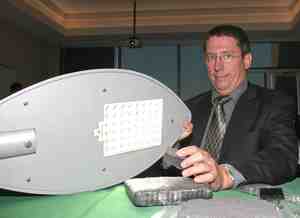
ORNL researcher James Klett developed a graphite foam technology that can help cool LED light fixtures and extend their lifespan.
Ein spezieller Graphit-Schaum, entwickelt von Forschern am Oak Ridge National Laboratory (ORNL), ermöglicht eine passive Kühlung von Leuchtdioden. Die Lösung verspricht eine längere Lebensdauer und das Kohlenstoffmaterial ist laut ORNL auch günstiger als andere Kühlkörper. Der US-Hersteller LED North America wird unter anderem LED-Straßenlampen mit dem Graphit-Schaum ausrüsten.
Es gilt der Originaltext in englischer Sprache.
ORNL graphite foam technology licensed to LED North America
Technology developed at the Department of Energy’s Oak Ridge National Laboratory that extends the life of light-emitting diode lamps has been licensed to LED North America.
The agreement signed today exclusively licenses a graphite foam technology developed by James Klett of ORNL’s Materials Science and Technology Division. LED North America intends to use the graphite foam to passively cool components in LED lamps, which are increasingly in demand in applications such as street lights and parking garage lighting. LED North America specializes in providing LED lighting products for municipal, commercial and industrial applications.
Cooling LED lamps is critical to increasing their efficiency, considering that each 10-degree decrease in temperature can double the life of the lighting components. Using graphite foam to more efficiently manage the heat of LEDs could help extend the lamp’s lifespan and lower its price, making the lamps more attractive to a broader consumer base. ORNL’s James Klett hopes the graphite foam can offer potential savings for customers.
„While this technology will reduce temperatures and increase the life of the LED lighting systems, what it will really do is save municipalities millions of dollars every year in replacement fixture costs as well as maintenance,“ Klett said.
The newly licensed graphite foam invention offers many advantages over comparable heat sink materials such as copper and aluminum. Graphite foam’s high thermal conductivity, low weight and easy machinability give the material greater design flexibility and make it a lighter, cheaper and more efficient cooling option.
The foam’s unusual graphite crystal structure is the key to its conductivity. It has a skeletal structure full of air pockets, making it only 25 percent dense and lightweight. The network of ligaments in the foam wicks heat away from its source, making it an excellent candidate to cool the LED lamp components.
Championed as an energy saving lighting source, LEDs are becoming more widespread due to their low energy consumption, compact size and long life expectancy. Improved LED performance will enable LED North America to offer longer warranty periods than its competitors. LED North America’s relationship with ORNL helped prompt Andrew Wilhelm, one of the company’s founders, to locate the company in Tech 2020, a business incubator in Oak Ridge.
„The proximity to ORNL gives the us the opportunity to work closely with ORNL researchers to further refine the integration of the graphite foam material into LED lamps,“ Wilhelm said.
ORNL is managed by UT-Battelle for the Department of Energy’s Office of Science.
